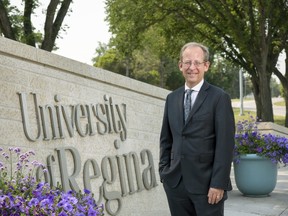The University of Regina has experienced extraordinary growth over the past five decades. Today, the university offers world-class, post-secondary education to more than 16,500 students.

Article content
Canada Day in 1974 was like no other day in the history of the University of Regina (U of R). Although the university traces its roots back to 1911, the U of R officially became an independent institution 50 years ago on that day.
“The growth since that time has been extraordinary,” said Dr. Jeff Keshen, U of R president and vice-chancellor. “There were a couple of buildings in an empty field and there was hardly any traffic along Wascana Parkway. Now the campus is a multi-dimensional complex that includes research facilities and innovation centres that are home to Canada Research Chairs who are some of Canada’s leading researchers.”
Advertisement 2
Article content
Article content
The U of R was originally established in 1911 by the Methodist Church (later known as the United Church of Canada) as a small residential high school and junior college named Regina College. In 1934 it became affiliated with the University of Saskatchewan in Saskatoon, which allowed its students to receive degrees. In 1961 the university became the Regina Campus of the University of Saskatchewan and began offering a wider range of undergraduate degrees. This helped set the stage for the U of R to become a separate university entity in 1974.
The campus during the mid-1960s featured three buildings: the Classroom Building, the Lab Building and the Library Building. The historic College Avenue Campus included the College Building, the Conservatory, Darke Hall and the Fine Arts Department in the former Normal School Building.
Ground-breaking ceremonies became the norm over the next few decades. Construction projects included the Physical Plant, Administration-Humanities Building, College West, Education Building, Riddell Centre, Centre for Kinesiology, Health and Sport, Research and Innovation Center, and several residences.
Article content
Advertisement 3
Article content
As the size of the campus was expanding, so too was its stature.
“In 1976, under the leadership of then-president Dr. Lloyd Barber, we were one of the first universities in North America to open up relations with China, which was quite extraordinary,” said Keshen. “At about the same time we began our relationship with what would ultimately be known as the First Nations University of Canada (FNUniv).”
First Nations University emerged from a desire to provide Indigenous peoples in Canada with culturally relevant, academic opportunities. Formerly housed in the College West Building and called the Saskatchewan Indian Federated College, it became the First Nations University of Canada and opened its new campus in 2003.
Federated colleges have served as additional building blocks in the university’s growth. Campion College and Luther College are both affiliated with the U of R, where they offer their own academic programs, but are integrated into the broader academic and campus community.

Keshen is particularly proud of the support network the U of R offers to all students. “We give them real life experiences through their course work, and provide support to those who need a helping hand. We opened our new Wellness Centre last year; the only wellness centre on a Canadian university campus that is run by nurse practitioners. We also opened our Centre for Experiential Learning and Service Learning, to provide applied and community-based learning experiences for every student in the university.”
Advertisement 4
Article content
Today’s University of Regina offers world-class, post-secondary education to more than 16,500 students, including almost 1,000 nursing and social work students based at the U of R’s Saskatoon campus.
With more than 88,000 alumni, U of R graduates are making a positive difference here in Saskatchewan and around the world.
With so many accomplishments over the last five decades, Keshen said it’s time to celebrate. There will be several 50th anniversary-branded, campus-wide events to look forward to. These include Welcome Week to start the fall semester, and the U-Prairie Challenge Kick-Off Football Game in early September.
Those will be followed by other special events such as Alumni Week in October, which will include a Class of ’74 reunion, a Retirees Event, the Alumni Crowning Achievement Awards, and a throwback concert at the Owl. There will also be a student and faculty research showcase in November and a few special holiday events in December.
Other things to watch for are research talks about the history, a new 50th anniversary logo, and commemorative clothing. A website is being created that will be launched in April so the community can stay up to date on the activities.
“The biggest events will take place in the fall when we have all the students back on campus,” said Keshen. “Things are still being finalized, but it’s going to be quite a party.”
THIS STORY WAS CREATED BY CONTENT WORKS, POSTMEDIA’S COMMERCIAL CONTENT DIVISION.
Article content



